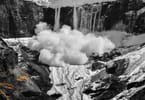The building of the GIBE III dam and hydro-electric power plant is attracting yet more opposition from the international environmental watchdogs, relevant NGOs, local advocacy groups, and the affected communities following ever more details emerging over the scale of displacement of local people living in affected areas.
The opposition movement also gained further strength, when the Gibe II dam partly collapsed only days after formally commissioning it, resulting in accusations of shoddy work and warning of the potential fallout should something like this also happen at the Gibe III project.
The “stop the dam” campaign is being taken to the African Development Bank, the World Bank, the European Investment Bank, and other financial institutions thought to be availing finance for the project, demanding firm action of them over claims that their own internal guidelines over the building of dams had been shoved aside and that the financiers’ environmental policies and regulations had been ignored by the developers, the government, and the participating companies and agencies, in favor of a fast tracking of the proposed 1.800 MW power plant, said to cost nearly US$2 billion when completed.
Added allegations have also now been made over deals the Ethiopian government allegedly made with international firms to grow bio fuel crops in areas around the proposed dam and resulting lake at the expense of literally chasing the present tens if not hundreds of thousands of residents away with little, if any, hope of finding them suitable grazing grounds for their livestock or arable land for cultivation elsewhere. The same organizations also alleged that the government in Addis Ababa is systematically dissolving community organizations to stifle protests, prevent community meetings, and generally doing all it can to keep the truth from area residents.
Across the border in Kenya there is further concern over the remaining waters the Omo river may eventually carry into Lake Turkana, which in recent years has already shrunk sizeably as a result of drought, less and less water inflow, and increased evaporation of surface water as a result of rising temperatures. It is estimated that nearly 90 percent of the water inflow to Lake Turkana comes from the Omo river and that any further reduction might prove too much for the lake to survive as a source of fresh water and fish due to the expected rise in salinity of the water then remaining.
The lake, once teeming with Nile Perch and other fish species, has lost much of its biodiversity in past decades already, and nomadic tribes living off their herds of goat and cattle find it increasingly more difficult to water their animals as the shores of the lake continue to recede further and further.
UNESCO has made Lake Turkana and part of the Omo valley into World Heritage sites, a status under growing threat of being withdrawn to the detriment of tourism operators bringing visitors to these remote places. Dr. Leakey, whose family rose to international fame for their digs in Olduvai/Tanzania and Kobi Fora along Lake Turkana and their finds of evidence of our human ancestors, has added his voice to the growing chorus of opposition, reportedly calling the project “fatally flawed” and alleging that “…the EIA was an inside job that has come up with the results they were looking for to get the initial funding for this dam.” Strong words but clearly justified and from someone so highly respected that it will be hard to dismiss his concern or rubbish him professionally.
Other sources in Kenya further claim and allege that the Environmental Impact Assessment (EIA) was done retrospectively, without any of the internationally-required stakeholder consultations and kept under lock and key, only for the eyes of financiers who were meant to be duped into believing the allegedly concocted report. The impact on Lake Turkana and the Omo river is, according to the report, very small and the number of nomads and communities living in the area has been reduced to a fraction of the real populations, reminding this correspondent of the similar attempts by AES of Virginia made 10 years ago in their initial studies for the Bujagali dam, where they were also belittling the tourism value of the upper Nile valley to a laughable figure in the face of reality on the ground. Ten years down the line, they still stand exposed for this gross attempt to mislead.
The Kenyan government and National Environment Management Authority (NEMA) in Nairobi have also come under scrutiny over their behind-closed-door dealings with the Ethiopians, but apparently an agreement has been signed between the two countries to connect the power grids, paving the way to import hydro-electric power from Ethiopia into Kenya without following the proper procedure of undertaking a separate EIA and assessing the impact of the Gibe III dam project on the Kenyan side of the border.
This correspondent only recently reported on plans to build two wind-propelled power plants in the wider Turkana region, able to generate up to 600 MW, while the importation of electricity from the disputed plant would more than likely only provide 400 MW. Activists from Kenya, Turkana, and their international supporters will be engaging Ethiopia more and more in the international arena from here forward and will undoubtedly leave no stone unturned to either stop or significantly alter the project for the good of the long-term survival of the environment.
WHAT TO TAKE AWAY FROM THIS ARTICLE:
- The impact on Lake Turkana and the Omo river is, according to the report, very small and the number of nomads and communities living in the area has been reduced to a fraction of the real populations, reminding this correspondent of the similar attempts by AES of Virginia made 10 years ago in their initial studies for the Bujagali dam, where they were also belittling the tourism value of the upper Nile….
- It is estimated that nearly 90 percent of the water inflow to Lake Turkana comes from the Omo river and that any further reduction might prove too much for the lake to survive as a source of fresh water and fish due to the expected rise in salinity of the water then remaining.
- Added allegations have also now been made over deals the Ethiopian government allegedly made with international firms to grow bio fuel crops in areas around the proposed dam and resulting lake at the expense of literally chasing the present tens if not hundreds of thousands of residents away with little, if any, hope of finding them suitable grazing grounds for their livestock or arable land for cultivation elsewhere.






















